County in Utah
| Grand County | |
|---|---|
| County | |
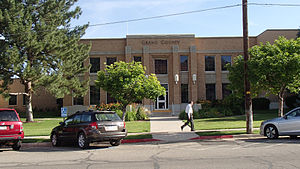 Grand County Courthouse, June 2014 Grand County Courthouse, June 2014 | |
 Seal Seal | |
 Location within the U.S. state of Utah Location within the U.S. state of Utah | |
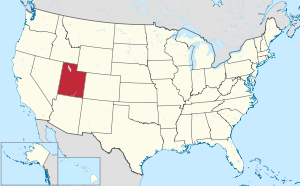 Utah's location within the U.S. Utah's location within the U.S. | |
| Coordinates: 38°59′N 109°34′W / 38.99°N 109.56°W / 38.99; -109.56 | |
| Country | |
| State | |
| Founded | March 13, 1890 |
| Named for | Grand River (now the Colorado River) |
| Seat | Moab |
| Largest city | Moab |
| Area | |
| • Total | 3,684 sq mi (9,540 km) |
| • Land | 3,672 sq mi (9,510 km) |
| • Water | 12 sq mi (30 km) 0.3% |
| Population | |
| • Total | 9,669 |
| • Estimate | 9,706 |
| • Density | 2.6/sq mi (1.0/km) |
| Time zone | UTC−7 (Mountain) |
| • Summer (DST) | UTC−6 (MDT) |
| Congressional district | 3rd |
| Website | www |
Grand County is a county on the east central edge of the U.S. state of Utah, United States. As of the 2020 United States census, the population was 9,669. Its county seat and largest city is Moab.
Grand County is home to one of the nine statewide regional campuses of Utah State University (located in the city of Moab) and serves as a gateway to both Arches and Canyonlands National Parks.
History
Evidence of indigenous occupation up to 10,000 BCE has been previously discovered in Grand County. The present city of Moab is the site of pueblo farming communities of the 11th and 12th centuries. These groups had already vanished from the area when the first European explorers entered the country, with nomadic Ute tribes inhabiting the area at the time of contact.
The European-based settlement of the area began with the arrival of Mormon pioneers in 1847. By 1855 they had sent missionary settlers into eastern Utah Territory. An Elk Mountain Mission was established but closed after a few months due to Indian raids. For several decades after that, the future Moab area (known as "Spanish Valley") was visited only by trappers and prospectors. Permanent settlement began in 1877. These early settlers, coming in from the north, encountered the deep canyon walls of the Grand River and could not take wagons over or around the steep canyon walls.
They unloaded their supplies, dismantled the wagons, and lowered them by rope to the river valley. They then drove their oxen over a canyon rim, down deep sand dunes. After the wagons were reassembled and supplies reloaded, they made their way through the deep sand to the river. They found a place to ford the river below the present bridge in north Moab. They later established a ferry at the crossing site, which remained in use until the first bridge was built in 1921.
In 1881 the area was known as Grand Valley, and Moab was a "wild west" town. A 1991 visitor to Moab later said it was the toughest town in Utah because the area and surrounding country have many deep canyons, rivers, mountains, and wilderness areas, becoming a hideout for outlaws. The local economy was initially based on farming and livestock. Mining came in at the end of the 19th century, and the railroad arrived. The first school in the county was started in 1881. Mormon settlers began planting fruit trees by 1879, and by 1910 Moab was a significant fruit-production center.
Due to the distances involved, the settlers of eastern Emery County found it difficult to conduct county business in that county's seat. By March 13, 1890, their petitions caused the Utah Territory legislature to designate the eastern portion of the county as a separate entity, to be named Grand County, named for the Grand River (whose name was changed to Colorado River in 1921). The county boundaries were adjusted in 1892 and in 2003.
Exploration for deep petroleum deposits began in the 1920s, and this industry has significantly contributed to the economy since that time. Other significant industries include uranium mining and filmmaking.
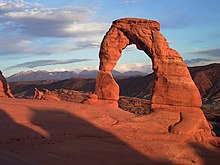
Geography
Grand County lies on the east side of Utah. Its east border abuts the west border of the state of Colorado. The Green River flows southward through the eastern part of central Utah, and its meandering course defines the western border of Grand County. The Colorado River enters the east side of Grand County from Colorado, flowing southwestward toward its confluence with the Green in San Juan County, south of Grand. The Dolores River also enters Grand County from Colorado, flowing westward to its confluence with the Colorado River near Dewey.
Grand County terrain is arid, rough, and spectacularly carved by water and wind erosion, exposing red rock formations that have created a solid tourist industry. The area is little used for agriculture unless irrigation is available. The terrain is filled with hills and protuberances, but generally slopes to the south and to the west. Its highest point is Mount Waas in the SE part of the county, at 12,336 ft (3,760 m) ASL. The county has a total area of 3,684 square miles (9,540 km), of which 3,672 square miles (9,510 km) is land and 12 square miles (31 km) (0.3%) is water. Deserts, cliffs and plateaus make up the scenery, with few settlements apart from the city of Moab, a Colorado River oasis. Arches National Park lies in the southern part of the county, just north of Moab. A northern portion of Canyonlands National Park lies in the southwest corner of the county.
Airport
- Canyonlands Field (CNY) northwest of Moab
Major highways
- United States Interstate I-70
- US-191
- Utah State Highway UT-128
- Utah State Highway UT-313
Adjacent counties
- Uintah County - north
- Garfield County, Colorado - northeast
- Mesa County, Colorado - east
- Montrose County, Colorado - southeast
- San Juan County - south
- Emery County - west
- Carbon County - northwest
Protected areas
- Arches National Park
- Canyonlands National Park (part)
- Dead Horse Point State Park (part)
- Manti-La Sal National Forest (part)
- McInnis Canyons National Conservation Area (part)
Lakes and reservoirs
- Beaver Pond
- Big Flat Reservoir
- Blue Flat Reservoir
- Crescent Wash Reservoir
- Dead Sheep Pond
- Dons Lake
- Hidden Lake
- Holding Pond
- Jackson Reservoir
- Ken's Lake
- Mud Lake
- Oowah Lake
- Pace Lake
- Rock Corral Reservoir
- Strychnine Pond
- Tenmile Wash Reservoir
- Tie Pond
- Twin Pond
- Valley City Reservoir
- Warner Lake
- Weaver Reservoir
- Yellow Cat Reservoir
Demographics
| Census | Pop. | Note | %± |
|---|---|---|---|
| 1890 | 541 | — | |
| 1900 | 1,149 | 112.4% | |
| 1910 | 1,595 | 38.8% | |
| 1920 | 1,808 | 13.4% | |
| 1930 | 1,813 | 0.3% | |
| 1940 | 2,070 | 14.2% | |
| 1950 | 1,903 | −8.1% | |
| 1960 | 6,345 | 233.4% | |
| 1970 | 6,688 | 5.4% | |
| 1980 | 8,241 | 23.2% | |
| 1990 | 6,620 | −19.7% | |
| 2000 | 8,485 | 28.2% | |
| 2010 | 9,225 | 8.7% | |
| 2020 | 9,669 | 4.8% | |
| US Decennial Census 1790–1960 1900–1990 1990–2000 2010 2020 | |||
2020 census
According to the 2020 United States census and 2020 American Community Survey, there were 9,669 people in Grand County with a population density of 2.6 people per square mile (1.0/km). Among non-Hispanic or Latino people, the racial makeup was 7,481 (77.4%) White, 65 (0.7%) African American, 330 (3.4%) Native American, 80 (0.8%) Asian, 11 (0.1%) Pacific Islander, 62 (0.6%) from other races, and 414 (4.3%) from two or more races. 1,226 (12.7%) people were Hispanic or Latino.
There were 4,810 (49.75%) males and 4,859 (50.25%) females, and the population distribution by age was 2,047 (21.2%) under the age of 18, 5,823 (60.2%) from 18 to 64, and 1,799 (18.6%) who were at least 65 years old. The median age was 40.5 years.
There were 4,006 households in Grand County with an average size of 2.41 of which 2,416 (60.3%) were families and 1,590 (39.7%) were non-families. Among all families, 1,676 (41.8%) were married couples, 260 (6.5%) were male householders with no spouse, and 480 (12.0%) were female householders with no spouse. Among all non-families, 1,206 (30.1%) were a single person living alone and 384 (9.6%) were two or more people living together. 1,123 (28.0%) of all households had children under the age of 18. 2,632 (65.7%) of households were owner-occupied while 1,374 (34.3%) were renter-occupied.
The median income for a Grand County household was $56,639 and the median family income was $68,216, with a per-capita income of $30,948. The median income for males that were full-time employees was $47,736 and for females $36,180. 14.0% of the population and 11.5% of families were below the poverty line.
In terms of education attainment, out of the 7,137 people in Grand County 25 years or older, 442 (6.2%) had not completed high school, 1,931 (27.1%) had a high school diploma or equivalency, 2,576 (36.1%) had some college or associate degree, 1,233 (17.3%) had a bachelor's degree, and 955 (13.4%) had a graduate or professional degree.
Religion
Grand County has the lowest percentage of members of the Church of Jesus Christ of Latter-day Saints (LDS Church) among all Utah counties. About 26% of Grand County residents identify as Latter-day Saints, significantly lower than the 62% of Utah as a whole.
Politics and government
Historically, following the period of William Jennings Bryan and Woodrow Wilson, Grand County has generally voted Republican. Between 1920 and 1988 (inclusive), it voted Democratic only four times: thrice for Franklin Roosevelt, and once for Lyndon Johnson. However, it has become a swing county in recent years, voting Democratic four times in the last nine presidential elections (for Bill Clinton in 1992, Barack Obama in 2008, Joe Biden in 2020, and Kamala Harris in 2024). The highest vote share any Republican has received in the county in the last nine elections was 51.1% (by George W. Bush in 2004); Joe Biden's 53.9% was the highest vote share for any nominee of either party since 1988, as well as the highest for a Democrat in the county since 1936. In 2024, Kamala Harris became the first Democratic presidential nominee to win Grand County despite losing the presidential election since 1900.
Grand County is one of only thirteen counties to have voted for Obama in 2008, Romney in 2012, Trump in 2016, and Biden in 2020.
| Position | District | Name | Affiliation | First elected | |
|---|---|---|---|---|---|
| Senate | 27 | David Hinkins | Republican | 2008 | |
| House of Representatives | 69 | Christine Watkins | Republican | 2016 | |
| House of Representatives | 70 | Carl Albrecht | Republican | 2016 | |
| Board of Education | 14 | Mark Huntsman | Nonpartisan | 2014 | |
| Year | Republican | Democratic | Third party(ies) | |||
|---|---|---|---|---|---|---|
| No. | % | No. | % | No. | % | |
| 2024 | 2,327 | 43.70% | 2,828 | 53.11% | 170 | 3.19% |
| 2020 | 2,248 | 43.19% | 2,806 | 53.91% | 151 | 2.90% |
| 2016 | 1,975 | 42.93% | 1,960 | 42.60% | 666 | 14.48% |
| 2012 | 1,996 | 50.53% | 1,727 | 43.72% | 227 | 5.75% |
| 2008 | 1,871 | 45.65% | 2,067 | 50.43% | 161 | 3.93% |
| 2004 | 2,130 | 51.14% | 1,858 | 44.61% | 177 | 4.25% |
| 2000 | 1,822 | 50.42% | 1,158 | 32.04% | 634 | 17.54% |
| 1996 | 1,384 | 42.57% | 1,199 | 36.88% | 668 | 20.55% |
| 1992 | 1,100 | 32.91% | 1,160 | 34.71% | 1,082 | 32.38% |
| 1988 | 1,895 | 58.34% | 1,287 | 39.62% | 66 | 2.03% |
| 1984 | 2,463 | 73.15% | 876 | 26.02% | 28 | 0.83% |
| 1980 | 2,362 | 70.42% | 703 | 20.96% | 289 | 8.62% |
| 1976 | 1,781 | 62.38% | 931 | 32.61% | 143 | 5.01% |
| 1972 | 1,837 | 72.15% | 560 | 22.00% | 149 | 5.85% |
| 1968 | 1,435 | 60.88% | 707 | 30.00% | 215 | 9.12% |
| 1964 | 1,130 | 49.67% | 1,145 | 50.33% | 0 | 0.00% |
| 1960 | 1,130 | 58.40% | 805 | 41.60% | 0 | 0.00% |
| 1956 | 1,044 | 76.09% | 328 | 23.91% | 0 | 0.00% |
| 1952 | 675 | 72.27% | 259 | 27.73% | 0 | 0.00% |
| 1948 | 418 | 50.54% | 400 | 48.37% | 9 | 1.09% |
| 1944 | 428 | 52.64% | 380 | 46.74% | 5 | 0.62% |
| 1940 | 432 | 49.04% | 446 | 50.62% | 3 | 0.34% |
| 1936 | 272 | 33.62% | 521 | 64.40% | 16 | 1.98% |
| 1932 | 278 | 34.53% | 506 | 62.86% | 21 | 2.61% |
| 1928 | 347 | 52.58% | 310 | 46.97% | 3 | 0.45% |
| 1924 | 278 | 47.93% | 243 | 41.90% | 59 | 10.17% |
| 1920 | 306 | 51.17% | 278 | 46.49% | 14 | 2.34% |
| 1916 | 213 | 39.52% | 306 | 56.77% | 20 | 3.71% |
| 1912 | 191 | 33.75% | 212 | 37.46% | 163 | 28.80% |
| 1908 | 232 | 48.74% | 215 | 45.17% | 29 | 6.09% |
| 1904 | 262 | 57.21% | 165 | 36.03% | 31 | 6.77% |
| 1900 | 178 | 46.11% | 204 | 52.85% | 4 | 1.04% |
| 1896 | 28 | 9.59% | 264 | 90.41% | 0 | 0.00% |
Moab has a significant environmentalist population due to nearby Arches National Park and Canyonlands National Park.
Sagebrush Rebellion
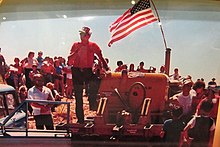
Grand County was an epicenter of the Sagebrush Rebellion, which took place during the late 1970s and early 1980s when residents protested what they saw as overreaching Federal control of Western US land.
An early event in the Rebellion was July 4, 1980, when 300 Grand County residents gathered behind a flag-decorated bulldozer in protest of the inclusion of Mill Creek Canyon as part of a Bureau of Land Management wilderness study area. Despite plowing nearly 200 yards up the canyon, the group did not reach the study area's boundary.
Paleontology
The Denver Museum of Natural History opened a small Cedar Mountain Formation quarry that has produced diverse dinosaur fossils including theropod, sauropod and ornithopod. An adult sauropod was designated the type specimen of the genus Venenosaurus.
Communities
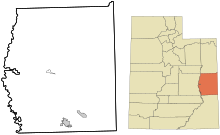
Cities
- Moab (county seat)
Towns
Census-designated places
Unincorporated communities
Former communities
See also
- National Register of Historic Places listings in Grand County, Utah
- Greentown Gas Condensate Field
- Moab uranium mill tailings pile
- List of counties in Utah
Notes
- The other twelve are Butte County, California; Teton County, Idaho; Kent County, Maryland; Kendall County, Illinois; McLean County, Illinois; Tippecanoe County, Indiana; Kent County, Michigan; Leelanau County, Michigan; Carroll County, New Hampshire; Rockingham County, New Hampshire; Marion County, Oregon; and Albany County, Wyoming.
References
- "Grand County, Utah". United States Census Bureau. Retrieved June 30, 2023.
- "Find a County". National Association of Counties. Archived from the original on May 31, 2011. Retrieved June 7, 2011.
- History of Grand County. Grand County website (accessed 28 March 2019)
- Grand County UT Google Maps (accessed 28 March 2019)
- Three sources list three different elevations for Mt. Waas. NAVD88: 12336. Peakbagger (Utah County High Points): 1,2331. gnis|1446945 : 12,306
- "2010 Census Gazetteer Files". US Census Bureau. August 22, 2012. Retrieved March 27, 2015.
- "Ken's Lake". January 7, 2021.
- "Pace Lake".
- "Warner Lake".
- "US Decennial Census". US Census Bureau. Archived from the original on April 26, 2015. Retrieved March 27, 2015.
- "Historical Census Browser". University of Virginia Library. Retrieved March 27, 2015.
- Forstall, Richard L., ed. (March 27, 1995). "Population of Counties by Decennial Census: 1900 to 1990". US Census Bureau. Retrieved March 27, 2015.
- "Census 2000 PHC-T-4. Ranking Tables for Counties: 1990 and 2000" (PDF). US Census Bureau. April 2, 2001. Retrieved March 27, 2015.
- "State & County QuickFacts". United States Census Bureau. Archived from the original on June 6, 2011. Retrieved December 29, 2013.
- 2020 Population and Housing State Data | Utah
- United States Census Bureau. "2020 Census Demographic and Housing Characteristics File (DHC)". Retrieved November 3, 2024.
- United States Census Bureau. "American Community Survey 5-Year Data (2009-2022)". Retrieved November 3, 2024.
- Corine Gotti. "The Mormon Gender Gap Widens" Beliefnet.com, accessed October 28, 2017
- "Senator Hinkins Utah Senate". senate.utah.gov. Retrieved November 16, 2021.
- "Rep. Watkins, Christine F." Utah House of Representatives. Archived from the original on November 17, 2021. Retrieved November 17, 2021.
- "Rep. Albrecht, Carl R." Utah House of Representatives. Archived from the original on November 17, 2021. Retrieved November 17, 2021.
- "Mark Huntsman". www.schools.utah.gov. Archived from the original on November 15, 2021. Retrieved November 15, 2021.
- Leip, David. "Atlas of US Presidential Elections". uselectionatlas.org. Retrieved November 24, 2020.
- "First US Tar Sands Mine Could Open in Utah". Reuters. Archived from the original on April 26, 2013. Retrieved November 25, 2012.
- Tidwell, V., Carpenter, K. & Meyer, S. 2001. New Titanosauriform (Sauropoda) from the Poison Strip Member of the Cedar Mountain Formation (Lower Cretaceous), Utah. In: Mesozoic Vertebrate Life. D. H. Tanke & K. Carpenter (eds.). Indiana University Press, Eds. D.H. Tanke & K. Carpenter. Indiana University Press. 139-165.
Further reading
- (1994) "Grand County" article in the Utah History Encyclopedia. The article was written by Gary Topping and the Encyclopedia was published by the University of Utah Press. ISBN 9780874804256. Archived from the original on March 21, 2024, and retrieved on May 3, 2024.
External links
| Places adjacent to Grand County, Utah | ||||||||||||||||
|---|---|---|---|---|---|---|---|---|---|---|---|---|---|---|---|---|
| ||||||||||||||||
| Municipalities and communities of Grand County, Utah, United States | ||
|---|---|---|
| County seat: Moab | ||
| City |  | |
| Town | ||
| CDP | ||
| Indian reservation | ||
| Ghost towns | ||
| Footnotes | ‡This populated place also has portions in an adjacent county or counties | |